The Serpent and the Rainbow Blu-ray Movie
HomeThe Serpent and the Rainbow Blu-ray Movie 
Collector's EditionShout Factory | 1988 | 97 min | Rated R | Feb 23, 2016
Movie rating
6.8 | / 10 |
Blu-ray rating
| Users | 4.0 | |
| Reviewer | 4.0 | |
| Overall | 4.0 |
Overview
The Serpent and the Rainbow (1988)
An anthropologist goes to Haiti after hearing rumors about a drug used by black magic practitioners to turn people into zombies.
Starring: Bill Pullman, Cathy Tyson, Zakes Mokae, Paul Winfield, Brent JenningsDirector: Wes Craven
| Horror | Uncertain |
| Thriller | Uncertain |
Specifications
Video
Video codec: MPEG-4 AVC
Video resolution: 1080p
Aspect ratio: 1.78:1
Original aspect ratio: 1.85:1
Audio
English: DTS-HD Master Audio 2.0 (48kHz, 24-bit)
Subtitles
English SDH
Discs
50GB Blu-ray Disc
Single disc (1 BD)
Packaging
Slipcover in original pressing
Playback
Region A (locked)
Review
Rating summary
| Movie | 4.5 | |
| Video | 4.0 | |
| Audio | 4.0 | |
| Extras | 3.5 | |
| Overall | 4.0 |
The Serpent and the Rainbow Blu-ray Movie Review
One of Craven's most underrated works makes its US debut.
Reviewed by Dr. Stephen Larson January 15, 2017It would be unthinkable today if one of the Hollywood majors even considered perusing a treatment or spec script resembling a colossal production
along the lines of The Serpent and the Rainbow. While not hugely expensive to make at Universal Pictures, Wes Craven's 1988 film
required a large number of extras across the Dominican Republic and Haiti during a period of political turmoil (the Duvalier dictatorship). Very
loosely based on renowned anthropologist Wade Davis's eponymous 1985 book, the movie stars Bill Pullman as the Davis-inspired ethnobiologist
Dennis Alan, a Harvard University scientist contracted by pharmaceutical giant Boston BioCorp to investigate the medicinal ingredients for
"zombification" in the Amazon basin. The film opens with a prologue set in 1978 with voodooists nailing coffin lids shut. One man, the local villager
Christophe Durand (Conrad Roberts), has been administered with a special drug and being prepared for burial. Is Durand being euthanized and is
he really dead? Like Carl Dreyer did in his first sound film, Vampyr (1931), Craven and his cinematographer John Lindley take the
perspective of the living corpse inside the coffin. As the lid is being sealed, a tear streams down Durand's cheek. Alan later discovers through the
occultist Louis Mozart (Brent Jennings) that these poor innocent village people are given a hex powder that renders them comatose but
doesn't really kill them. They eventually resurface on the streets stripped of their original identities and working for a corrupt regime. Joining Alan
in his investigation of the "buried alive" is the beautiful doctor, Marielle Duchamp (a lovely Cathy Tyson), and her benevolent voodoo father, Lucien
Celine (Paul Winfield). Opposing Alan on his field research expedition is the menacing Dargent Peytraud (Zakes Mokae), the leader of the Tontons
Macoute, Haiti's secret police.
The Serpent and the Rainbow is regarded as a relatively minor work in Craven's filmography, a shame considering that it's an outstanding
horror thriller that broke new ground at the time. In the audio commentary included on the disc, Pullman states that Craven resisted the
temptation to make a straight-up horror picture but was pressured by studio moguls and an aggressive ad campaign to make a more standard
genre film that would cater to Craven's fan base. Pullman believes that Craven caved into Universal's demands with a formulaic third act that
treads a by-the-numbers thriller. I disagree in the sense that the narrative structure of the film dictates a dramatic conclusion pitting a showdown
between Alan and Peytraud, who represent warring ideologies. It is true that the final act and the rest of the picture contain visual references to
other films that Craven has either wrote or directed. But he presents these scenes in fresh ways, thanks to the marvelous special effects work of
Dave Anderson and Lance Anderson (among others). TSatR signifies a breakthrough for Craven courtesy of its exoticness in a faraway
land, voodoo dance rituals that bristle with energy and surprise, and insightful exploration of black magic. The movie evolves into horror with
Craven remaining faithful to his signature style without repeating himself.
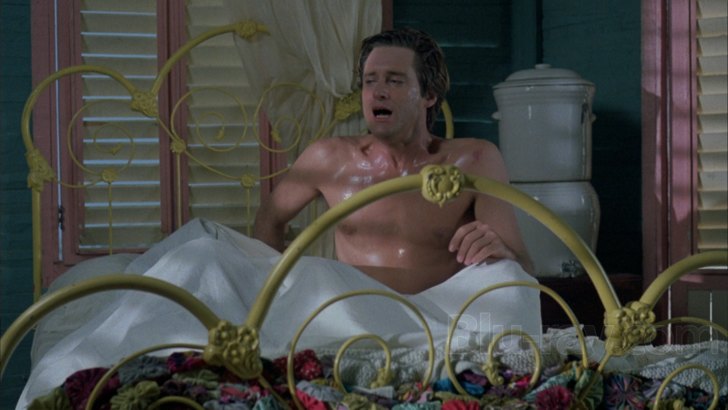
Is Dr. Alan only having nightmares or experiencing them in reality as well?
I concur with The Washington Post's then-film critic Desson Howe who wrote at the time that TSatR demonstrated Craven's maturity as a storyteller. The movie also shows how Craven honed his editing skills. This is not to imply that Craven's prior pictures are not well put together or lack a coherent editing style. Rather, it reveals that when he was equipped with a higher budget and more production resources, he could reach new heights in his craft. In a brilliant early sequence, for example, Alan is seemingly attacked by a baby jaguar who he ends up playing with. As he calms down, Peytraud surprises him like a pterodactyl, submerging him down a tunnel. Alan plunges into the abyss and as Craven shows him in a black hole, the researcher exits out of the hole into another realm. With characteristic ingenuity, Craven uses Alan's descent as a metonymic signifier for the unconscious. In another surreal sequence, Alan experiences a dream-within-a-dream with Durand bringing him a bridal corpse which unleashes a big snake from its mouth. While staying with Duchamp on an island, Alan dreams of the zombie's return on a fiery boat. Craven puts Alan and the audience in a most claustrophobic position; Alan is trapped and drowning in a blood bath.
In this film, Peytraud is Craven's version of Freddy. Like Elm Street's most infamous stalker, Peytraud acts as a dream master and soul stealer not only in Haiti but also in Boston. Craven cross-cuts between a voodoo blood ritual in a cave led by Peytraud and Alan attending a dinner party at the home of Andrew Cassedy (Paul Guilfoyle). Alan first notices an eye in his soup and then Mrs. Cassedy (Dey Young) acting strange. By showing Peytraud gain possession of Mrs. Cassedy in Boston, Craven reveals how evil can cut across geographic and regional lines to become an omnipotent, pervasive force.
The Serpent and the Rainbow Blu-ray Movie, Video Quality 
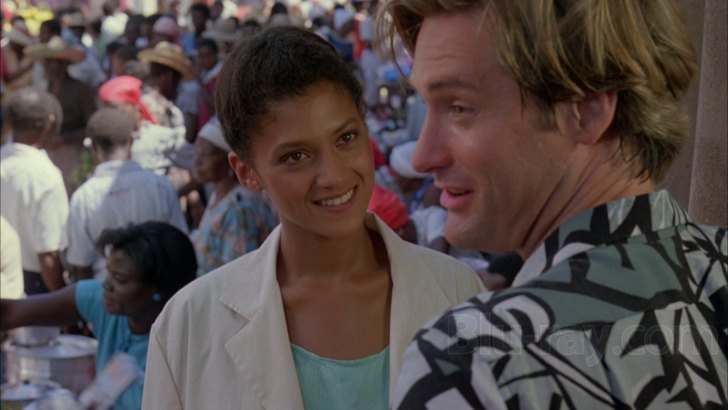
The Serpent and the Rainbow makes its American debut on Blu-ray courtesy of Shout! Factory. Fortunately, Shout! had archival elements
that were in very good shape to work with. A brief video history of TSatR will illumine some of those materials. Image Entertainment put
Craven's film on DVD in 1998 with a 1.85:1 anamorphic widescreen transfer culled from the original 35mm theatrical prints. According to DVD
Review writer Guido Henkel, the picture sported "a stunning image with deep blacks....the image is beautiful and absolutely clean, free of any
scratches or marks from the original film material. The film boasts strong colors, bringing to live [sic] the colorfully blazing settings in Haiti and the
South-American Amazon regions. It captures much of the exotic locations and the culture and this transfer reproduces every little detail. The
compression is flawless, without artifacts or pixelation, and colors are not only strong but also faithfully reproduced, even under the most demanding
lighting settings. The dark night shots maintain plenty of shadow detail and give the imagery an astounding depth. Chroma noise or color smearing
are literally non existent on this great disc." In 2009, Universal Studios released TSatR on DVD as part of The Wes Craven Horror
Collection. It is unknown whether Universal reused Image's transfer but compression was inferior as TSatR was paired on the same disc
with Shocker. As Eric Goldman of IGN observed in his review of the set, TSatR's picture possessed "dull looking color and grain
abounds."
The great news is that Shout! retains the color densities of Image's disc and presents them in a mostly sparkling transfer in high-definition on this
AVC-encoded BD-50. Shout! also went the extra mile by acquiring new interpositive film elements in 2015, according to an advertisement.
TSatR appears in an aspect ratio of about 1.78:1 that approximates its original theatrical exhibition of 1.85:1. Fabulous Films released the film in the UK during spring, 2015 (with BBFC
cut by a few seconds) in its native 1.85 and I have scrutinized frame enlargements between Fabulous and Shout!. The US edition shows a bit more
information on the top and bottom; it also masks a tad on the left and right edges but differences along the sides are pretty negligible. Fabulous also
boosts brightness by a small notch. While I did not see TSatR during its theatrical run in 1988, I can vouch based on my knowledge of its
production history that the overall color temperature and flesh tones appear completely naturalistic and spot-on without any digital manipulations.
The rain-forest scenes and countryside look vivid and occasionally spectacular (see Screenshot #s 5 and 15). The bolder colors sometime pop out on
the screen (check out the Old Shaman and his headdress in #17). The only blemishes that prevent the transfer from earning a higher score is a
sprinkling of tiny white speckles and small reel-change markings that occur during scene transitions. But this will not distract the viewer from a
beautiful presentation.
Shout! has divided the feature up into twelve scene selections.
The Serpent and the Rainbow Blu-ray Movie, Audio Quality 
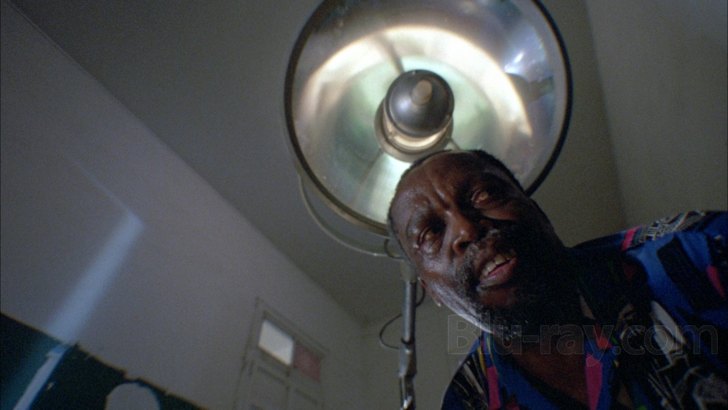
Shout! decided to retain the movie's original Dolby Suround 2.0 (rather than create a remix), rendered here in a DTS-HD Master Audio 2.0 track.
Shout! does a very nice job of capturing the sounds from the busy Haitian streets and ambient noises from the forest. The lossless mix creates an
equal balance between sound effects and music. A 5.1 remix may have produced more separation between the fronts and surrounds but I don't think it
was necessary. Dialogue isn't as prominent in the fronts as other sounds, save for Pullman's voice-over narration. Composer Brad Fiedel crafted one of
his best scores, which combines the pan flute with Haitian drum beats. His cue for the end credits contain pulsating synths that recall his main theme
for The Terminator. Indeed, his electronic music and sequencers in this score stand as a bridge between music Fiedel wrote for the 1984 sci-fi
classic and the more humanity-friendly themes he composed for the blockbuster sequel, T2: Judgment Day.
Shout! has equipped the main feature with optional white English SDH, which appear in italics for the voice-overs (see #20).
The Serpent and the Rainbow Blu-ray Movie, Special Features and Extras 
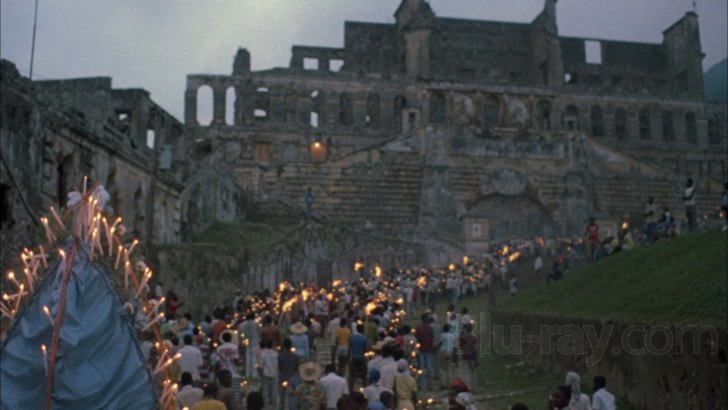
- NEW Audio Commentary with Bill Pullman - Pullman is joined by moderator Rob Galluzzo for a chat that runs for over half of the movie's total run time (53 minutes and 25 seconds). For not having having seen the film for almost eighteen years, Pullman has a surprisingly excellent memory as he vividly recalls various production anecdotes and working with Wes Craven. Pullman explains that he can't stay and finish the commentary till the end because he has to be on set the following morning in New Mexico (probably to shoot Independence Day: Resurgence, which was filmed in Albuquerque). In English, not subtitled.
- NEW The Making of THE SERPENT AND THE RAINBOW Featuring New Interviews with Actor Bill Pullman, Author Wade Davis, Director of Photography John Lindley, and Special Effects Artists Lance Anderson and David Anderson (23:58, 1080p) - a retrospective documentary on the making of TSatR. A majority of Pullman's remarks are extracted from the commentary (he doesn't appear in front of the camera). Wade Davis is interviewed via Skype and there are new interviews with cinematographer John Lindley as well as two of the makeup artists. In English, not subtitled.
- Original Theatrical Trailer (1:24, 1080p upconvert) and TV Spot (:32, 1080p upconvert) - an analog-sourced trailer and TV spot, both upconverted to HD. In English, not subtitled.
- Stills Gallery (5:09, 1080p) - a compilation of fifty-nine black-and-white/color lobby cards, production stills, and theatrical posters. Do note that there are publicity photos from Universal's 1990 home video ad campaign as the copyright date is listed by the descriptive captions.
The Serpent and the Rainbow Blu-ray Movie, Overall Score and Recommendation 
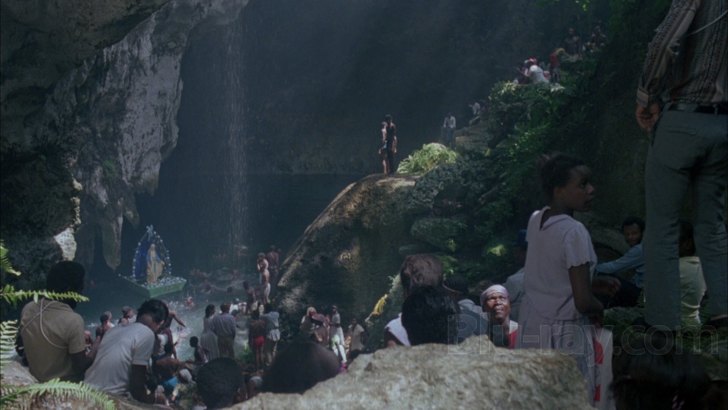
The Serpent and the Rainbow is a forgotten classic and one of Wes Craven's finest films. Shout! Factory's Collector's Edition has assembled something as close to a definitive package of the film as we can hope. It would have been nice if the label could have incorporated archival a/v interviews with Craven. (The Austrian Koch Media Blu-ray of TSatR contains an original six-minute 'Making Of' featurette as well as brief profiles of Davis and Craven. It only includes about fifteen minutes of bonus material, though.) Still, the Shout! disc represents the best overall version worldwide. Hopefully, this release will inspire a soundtrack label to reissue Brad Fiedel's orginal score. (I'm one of the lucky few to own the Varčse Sarabande album.) VERY HIGHLY RECOMMENDED to all horror fans.
Similar titles
Similar titles you might also like

Halloween Ends
2022

Child's Play
2019

Night Angel
1990

The Devil's Dolls
Worry Dolls
2016

V/H/S: Viral
2014

The Monkey's Paw
2013

Zombies of Mora Tau
1957

Venom
2005

Night of the Living Dead 4K
Theatrical (UHD/BD) and Workprint (BD) versions
1968

Dead & Buried 4K
Standard Edition
1981

Hatchet
Unrated Director's Cut
2006

Zombie 4K
Zombi 2 / Zombie Flesh Eaters
1979

Creepshow 4K
Collector's Edition
1982

Hatchet III
2013

I Drink Your Blood
Also Includes = I Eat Your Skin and Blue Sextet
1970

Beyond the Darkness
Buio Omega
1979

The Plague of the Zombies
1966

Zombie 4: After Death
Limited Edition of 3000 | Zombi 4 | Oltre la morte
1989

Vengeance of the Zombies
La rebelión de las muertas
1973

Amityville Dollhouse
1996
